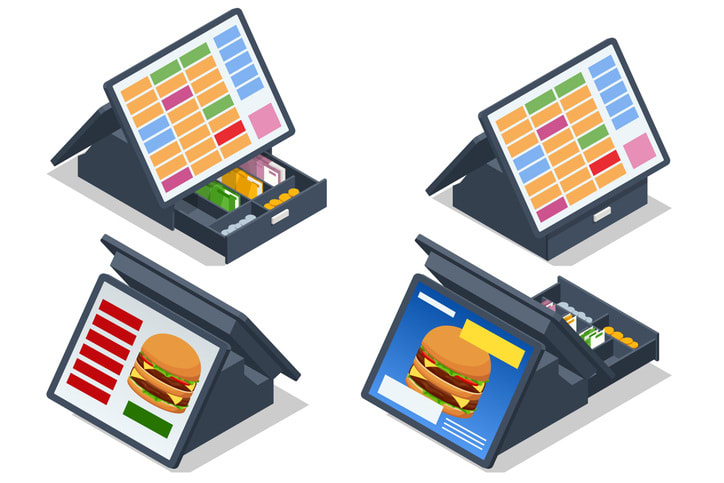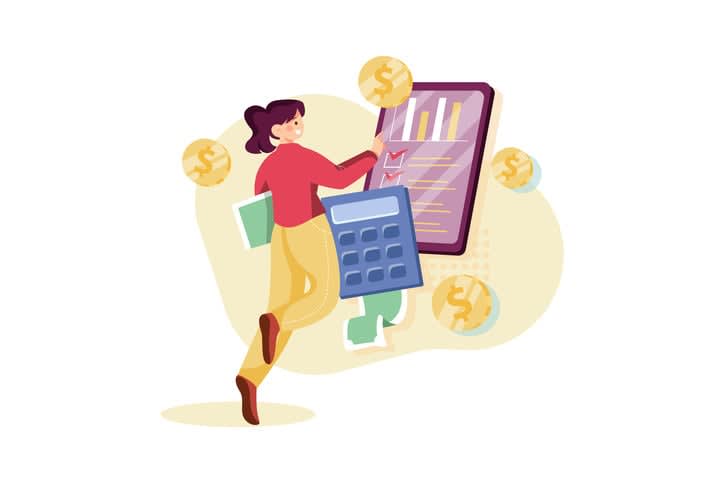Can a POS system transform your business operations? Efficient, practical, and essential - the right POS system streamlines sales, inventory tracking, and customer service for smoother retail operations. Dive into our comprehensive guide to understand the evolution, application, and impact of point-of-sale technology in today’s fast-paced store environment.
Key Takeaways
- POS systems are not just cash registers; they offer real-time inventory data, advanced management, sales reporting, and integrated customer loyalty programs, enhancing retail efficiency and customer satisfaction.
- Retailers can streamline operations and improve customer experiences by leveraging POS system capabilities like real-time inventory tracking, personalized interactions, and data-driven marketing campaigns.
- Ensuring the security of POS transactions is critical, requiring adherence to PCI DSS, routine updates, and cybersecurity training. Technological advancement and customization are vital to maintaining POS relevance and effectiveness in an increasingly analytics-focused market.
The basics of POS systems

At the heart of every successful retail operation lies a robust POS system, a transformative force that has redefined the sector. These systems, which stand at the intersection of service and sales, are not just about ringing up purchases; they’re about creating seamless retail experiences. With the advent of POS technology, gone are the days when cash registers merely kept track of sales and stored cash.
Today’s POS systems are complex, integrated networks that provide:
- Real-time inventory data
- Email receipts for customers, saving paper
- Advanced inventory management
- Comprehensive sales reporting
- Integrated customer loyalty programs
- Invaluable insights into customer payment preferences, allowing businesses to optimize checkout processes for enhanced speed and efficiency.
But how did we arrive at this point, and what does the evolution of these systems look like?
Whatever your retail or service operation, Kumospace provides collaboration tools to broaden knowledge sharing across sales, marketing, supply chain, and retail operations. In meetings, using retail data and insights from POS apps, everyone can view the sales landscape, understand problems, and suggest solutions. Teams can also generate new ideas to improve turnover and broaden their understanding of POV systems' value.
Cash register evolution
The cash register has come a long way since its inception as a mechanical device to deter employee theft. Initially, these rudimentary machines did little more than tally sales and provide a secure place to store cash. However, the quest for accuracy and financial control within businesses spurred a technological revolution.
Cash registers evolved into electronic connected systems with digital displays and the ability to link to back-office applications. The real game-changer was the integration of inventory management systems, which brought real-time tracking of sales and inventory adjustments, coupled with barcode scanners that accelerated the checkout process.
Cashier and mobile terminals are the primary POS systems in use. Modern cashier terminals have bright displays that show customers' savings using store cards or coupons, improving customer satisfaction. Mobile terminals are small and all-weather, using mobile or WiFi connectivity.
The growth in self-checkout POS systems adds further features, such as refusing to sell restricted items to people who look too young, encouraging cashless checkout, and emailing receipts to save paper. Modern POS systems, alongside tools like Kumospace, create a better work environment for staff and customers.
With each leap forward, from customer displays to touchscreens and customized software solutions, POS systems have become more versatile, catering to various industry needs. Today’s POS systems have sophisticated features like EMV (Europay, Mastercard, and Visa) chip technology and NFC (Near Field Communication) wireless payment options, reflecting the widespread use of smart credit cards, smartphones, watches, and other convenient contactless payment methods.
The US POS market was valued at $4.97 billion in 2022, growing at a CAGR of 13.3% to 2030. Their value and flexibility make them a vital part of any retail business.
Online vs. physical POS
The POS landscape is vast, encompassing both the tangible world of brick-and-mortar retail and the virtual realm of online stores. These systems have adapted to handle many methods, from the traditional swipe of a credit card to digital wallets like PayPal or Venmo, ensuring customer convenience is never compromised.
This flexibility is a testament to the POS system’s ability to meet the demands of different retail environments, whether the tactile experience of a physical store or the click-centric nature of online shopping. This versatility makes POS systems indispensable to retail operations, providing a seamless transactional bridge between the retailer and the consumer.
Even in remote areas, mobile-connected POS terminals can track sales at festivals, rural events, farm stores, and similar locations, reporting to HQ and helping provide restocks as needed.
The impact of POS on the retail industry

The ripple effect of POS systems on the retail industry cannot be understated. They have revolutionized retail operations, turning arduous tasks into streamlined data-enabled processes.
The real-time tracking features of POS systems have drastically reduced the time and resources required for inventory management. This efficiency extends to checkout lines, where expedited payment processing has significantly curtailed customer wait times. Retailers who have embraced POS technology have witnessed an uptick in operational efficiency and improvements in customer retention thanks to personalized loyalty programs and promotions.
With faster service, retailers can accommodate more customers, reducing transaction times and improving customer service and satisfaction. Moreover, the wealth of comprehensive sales data at their fingertips enables retailers to make data-driven decisions, fine-tuning their sales strategies for maximum impact. But what specific operations are streamlined, and how does this benefit both the retailer and the customer when the customer executes a purchase?
Streamlining retail operations
In retail, efficiency is king, and POS systems reign supreme as tools of the trade. They allow retailers to:
- Integrate business orders seamlessly
- Bridge the gap between online purchases and in-store transactions for optimal inventory management
- Ensure real-time inventory tracking
- Maintain product availability and customer satisfaction
- Identify spikes in demand and potential suspicious activity
Modern POS systems have an easy-to-use interface featuring intuitive touchscreens that simplify operations. This allows for quick checkouts and easy access to frequently purchased items.
For chain businesses, online meetings through Kumospace can deliver training for new POS systems. Or, if temp workers for festivals or other events need information and support before they arrive on-site, trainers can provide coaching and insights online in a fun and morale-building way.
Mobile POS options have revolutionized the retail floor by enabling sales associates to process transactions on the spot. They reduce customer wait times and personalize the shopping experience.
Integrating data management tools in POS systems has been instrumental in optimizing workplace efficiency by monitoring employee productivity and establishing role-based access controls. Additionally, integrated inventory management within POS systems is pivotal in detecting and preventing potential employee theft or sales transaction manipulation.
Improving the customer experience
The power of POS systems to elevate the customer experience is a transformative aspect of retail operations. Some benefits of POS systems include:
- Personalizing the interaction by allowing sales associates to process transactions anywhere on the sales floor
- Minimizing the frustration of waiting in line
- Harvesting stored purchase history and consumer details, which are the lifeblood of personalized marketing campaigns and loyalty programs
- Fostering loyalty and encouraging repeat business through a data-driven approach to customer engagement
Additionally, with customized POS interfaces, retailers can provide an efficient and satisfying checkout experience, leading to improved customer retention. When creating a memorable shopping experience, POS systems are an essential tool for retailers to meet and exceed customer expectations.
Analyzing sales trends
The analytical power of POS systems is a treasure trove for retailers, helping store owners and HQ managers dissect sales data, including sales taxes, with surgical precision. Detailed transaction records, capturing the when, what, and how much of each sale, are foundational for predicting demand patterns and discerning sales trends.
This data is not merely a record of past transactions but a compass that guides future business strategies. Retailers can use the insights from POS systems to benchmark performance, identify sales variances, and adjust to seasonal fluctuations.
Moreover, aggregating customer buying habits and preferences paves the way for tailored shopping experiences, which can significantly enhance customer satisfaction. With the aid of POS system data, retailers can:
- Manage inventory with greater precision
- Schedule product ordering and promotions more effectively
- Optimize staffing levels to meet the ebb and flow of customer traffic
In essence, POS systems act as marketing maestros, orchestrating a symphony of data-driven strategies that resonate with the retailer’s goals and the customer’s desires. Amazon dominates the retail landscape with 50% of all retail activity, siphoning up 1 exabyte of retail and customer data for pricing and customization.
Smaller businesses can use their smarts and collaborative efforts to reduce the data imbalance, with workspaces like Kumospace acting as the springboard for creativity.
Customizing POS systems for specific needs

Customization is not just a luxury but a necessity for POS systems. Every business has unique requirements and challenges; tailoring POS systems can meet these needs. By integrating third-party applications such as:
- CRM
- Scheduling
- Loyalty programs
- Accounting
Businesses can refine their POS systems to align with operational needs, customer expectations, and industry regulations.
Custom POS solutions offer several benefits, including:
- Seamless integration with existing business systems
- Minimizing disruption
- Tailored reports and analytics for specific performance metrics and goals
- Identifying unique requirements and prioritizing essential features
By customizing POS systems, businesses can ensure that they cater perfectly to their specific demands.
Scalability is also a vital consideration; POS systems must be able to grow and adapt along with the business. SaaS solutions deliver daily improvements to maintain system performance and improve security. New feature additions like AI analytics and omnichannel retail support round out the application’s feature set over time, and ensure it will meet future business needs.
Essential tools for industries
POS software’s versatility shines when customized to cater to the diverse landscape of industries. Here are some examples:
- In the hospitality sector, POS systems allow customers to view menus and place orders from their tables, streamlining the transaction process and pay automatically to improve the dining experience.
- Retailers can use POS systems with price-checking tools and customizable displays to improve transaction efficiency and a store’s aesthetic appeal, enticing customers and meeting specific operational requirements.
- Industries that offer price comparisons (grocery store chains, hoteliers, and airlines) can perform live price checks in front of the customer.
On the other hand, service industries can leverage POS systems that offer quick access to frequently purchased items, various payment options, and omnichannel integration to create a seamless online and in-store experience. These tailored tools are crucial in providing the technology that supports the unique demands of different industries, ensuring that businesses can operate at their full potential.
Adapting to technological advancements
In today’s fast-paced world, staying ahead of the curve in terms of technology is vital for the success of any POS system. Regular updates and integration of the latest technological advancements are crucial for maintaining optimal performance and ensuring compatibility with emerging payment technologies. Businesses must proactively partner with reliable POS providers to ensure that their systems can adapt to the ever-changing landscape of payment processing and cybersecurity.
This commitment to staying current with technological trends secures the business’s investment in POS systems and guarantees that they will continue to meet customers’ needs and the marketplace's evolving expectations.
Ensuring security and privacy in POS transactions

In the digital age, where data breaches are unfortunately common, ensuring the security and privacy of POS transactions is paramount. Businesses must protect their customers’ sensitive data by adhering to Payment Card Industry Data Security Standards (PCI DSS), which outline best practices for handling payment information. Securing all aspects of a business’s network—including wifi, software, and hardware—is critical in safeguarding against unauthorized access to sensitive information through POS systems.
Clear policies for POS usage among employees are also essential. These policies help prevent unauthorized access by establishing procedures for logging out or locking POS systems when not in use. Training employees on cybersecurity best practices and fraud recognition is a proactive measure that can shield POS systems from threats like phishing attacks.
Surveillance and monitoring tools are another layer of defense, enabling businesses to oversee POS activities and detect any unusual patterns that could indicate potential fraud or theft.
However, how do businesses specifically secure customer data, and what measures are taken to protect the payment processing itself?
Securing customer data
Securing customer data in the POS ecosystem is a multifaceted endeavor that requires constant vigilance. Retailers must comply with PCI DSS, ensuring their payment software is fortified against malware and other threats with robust antivirus software. The implementation of routine software updates and security patches is also critical for reinforcing the security infrastructure around customer data. Some key steps to take include:
- Complying with PCI DSS standards
- Using robust antivirus software to protect against malware and other threats
- Implementing routine software updates and security patches
By following these steps, retailers can enhance the security of their customer data in the POS ecosystem.
Additionally, Data Loss Prevention (DLP) tools are instrumental in thwarting the unauthorized extraction of customer information, providing a safety net in the event of a system breach. Establishing role-based permissions and access controls is another effective strategy for mitigating risks associated with internal theft and unauthorized data distribution.
These security measures are not just about compliance; they are about preserving customers' trust in a business each time they swipe their debit cards or enter their payment details.
Safeguarding payment processing
The sanctity of payment processing is a cornerstone of retail trust and reliability. Swiped transactions, once the norm, now present a higher risk and are no longer protected against bank chargebacks in fraud cases. Regular inspections of POS hardware are a practical measure to identify any skimming devices or other unauthorized tools designed to capture payment information. Cloud-based POS systems offer an additional layer of security compared to on-premise systems, which are more susceptible to physical intrusion and data duplication.
Retailers must ensure PCI compliance and embrace technological innovations that enhance the security of the payment process. In doing so, they protect their customers and strengthen the integrity of their business operations.
Kumospace and POS: A winning combination

Collaboration and effective communication play pivotal roles in optimizing retail operations. This is where Kumospace enters the scene, acting as a collaborative platform that improves teamwork within retail and business environments.
Teams can tap into Kumospace to work effectively from any location, thus ensuring POS-related tasks are performed optimally and without geographical constraints.
The integration of Kumospace with POS services transforms it into a dynamic communication hub and digital workspace, facilitating discussions and strategies for leveraging POS technology to its fullest potential. But how exactly does Kumospace integrate with POS systems, and what are the tangible benefits for teams and customers alike?
For businesses looking beyond a pure retail play, other options include affiliate marketing to leverage other brands and services from which you can generate income.
Integrating Kumospace with POS systems
Integrating Kumospace with POS systems does more than just streamline communication; it creates a centralized hub for teams to collaborate and refine their operational strategies. This synergy results in a smoother transaction process, directly translating to an improved point of sale experience for customers. Retailers can customize Kumospace to meet the unique requirements of different teams, ensuring that the integration enhances the efficiency of sales transactions and, by extension, customer satisfaction.
By fostering a more connected and responsive team environment, businesses can react swiftly to POS system-related tasks, address issues in real-time, and keep all stakeholders in the loop on the latest developments and strategies. Sales enablement is another strategy that can
Training and support
Kumospace’s impact on employee training and support in the context of POS systems is significant. It provides a shared virtual workspace where employees can engage in interactive learning and support for POS systems. This collaborative environment is conducive to training employees on security best practices, including recognizing common phishing attempts and the importance of strong passwords, which is critical for protecting customer data.
Furthermore, Kumospace facilitates discussions and training sessions on the effective use of POS technology, ensuring that employees are well-versed in the features and functions of the systems they use daily. These benefits extend beyond the technical aspects, as they foster a culture of continuous learning and improvement, which is crucial for maintaining high levels of service and security.
Summary
As we draw this exploration to a close, it’s clear that POS systems are the lifeblood of modern retail operations. These sophisticated systems have evolved from simple cash registers to become powerful tools that streamline operations, safeguard transactions, and elevate the customer experience. Customization and adaptation to technological advancements ensure that POS systems meet specific business needs and stay ahead of the curve. Security and privacy measures are non-negotiable, with PCI compliance, regular updates, and employee training forming the bedrock of data protection. Integrating collaborative platforms like Kumospace further enhances the efficiency and dynamism of POS-related tasks, creating a cohesive ecosystem where teams can thrive. Retailers equipped with these insights are not just surviving but setting new standards for efficiency, security, and customer satisfaction.
Embrace the transformative power of POS systems and harness the full potential of your retail operations. Whether optimizing inventory management, personalizing the customer experience, or securing sensitive data, the right POS system, tailored to your specific needs, is a game-changer. By staying informed and proactive in leveraging these tools, retailers can not only meet the demands of today but also anticipate and adapt to the challenges of tomorrow. The future of retail is here, and it is efficient, secure, and customer-centric—powered by POS.
Frequently Asked Questions
A POS system in retail has essential functions such as real-time inventory tracking, sales reporting, CRM, and integration of loyalty programs, all of which aim to improve service quality and streamline store operations.
POS systems have evolved from mechanical devices to electronic systems with advanced capabilities like digital displays, barcode scanners, and diverse payment options, vastly improving transaction accuracy and efficiency.
POS systems contribute to enhancing customer experience by facilitating faster transactions with mobile POS options, utilizing customer data for personalized marketing campaigns, and offering customized interfaces that streamline the checkout process. These features ultimately provide a more convenient and tailored shopping experience for customers.
To secure POS transactions, businesses should adhere to PCI compliance, secure networks, establish usage policies, and train employees on cybersecurity best practices to prevent unauthorized access and data breaches. This will help in protecting sensitive transaction data and maintaining customer trust.
Kumospace complements POS systems by providing a collaborative platform that enhances team communication and streamlines operational strategies, which ultimately improves the overall efficiency at the point of sale.





